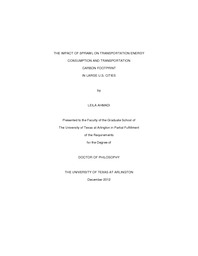| dc.description.abstract | Today, climate change and energy shortage are major concerns among scientists, politicians, and economists. For decades in the U.S., emphasis has been placed on improving energy efficiency through technological advances. However, most of these technologies are in the initial phases of development, while energy consumption continues to increase at a rapid pace. In order to solve this dilemma, there is a need to develop a faster and more effective approach for controlling the rates of energy consumption and demand. Transportation consumes more energy than other energy-dependent activities, such as those in the industrial, residential, and commercial sectors of the economy. In addition, the transportation sector produces the highest level emissions in comparison to the other energy- dependent activities. Because of this problem, it is important that more studies examine the problem of energy consumption and emissions within the transportation sector. Cities are the main producers of transportation emissions and energy use. Many researchers have considered spatial form of contemporary urban regions as a source of environmental problems. Therefore the goal of this study is to examine the relationship between urban sprawl, transportation energy consumption and the carbon footprint. The impact of sprawl on transportation energy consumption has been investigated using some urban areas in the U.S. as case studies. However, there is not a comprehensive study employing reliable data among metropolitan statistical areas (MSAs) across the U.S. To provide a better analysis, this dissertation examined the statistical strength between different urban forms, transportation energy consumption and carbon footprint among 73 MSAs in the U.S., using ordinary least square (OLS). The study found that a significant relationship between urban sprawl and transportation energy consumption and carbon footprint. Nevertheless, there are still more important factors that influence the transportation energy consumption and carbon footprint than urban sprawl. | en_US |

